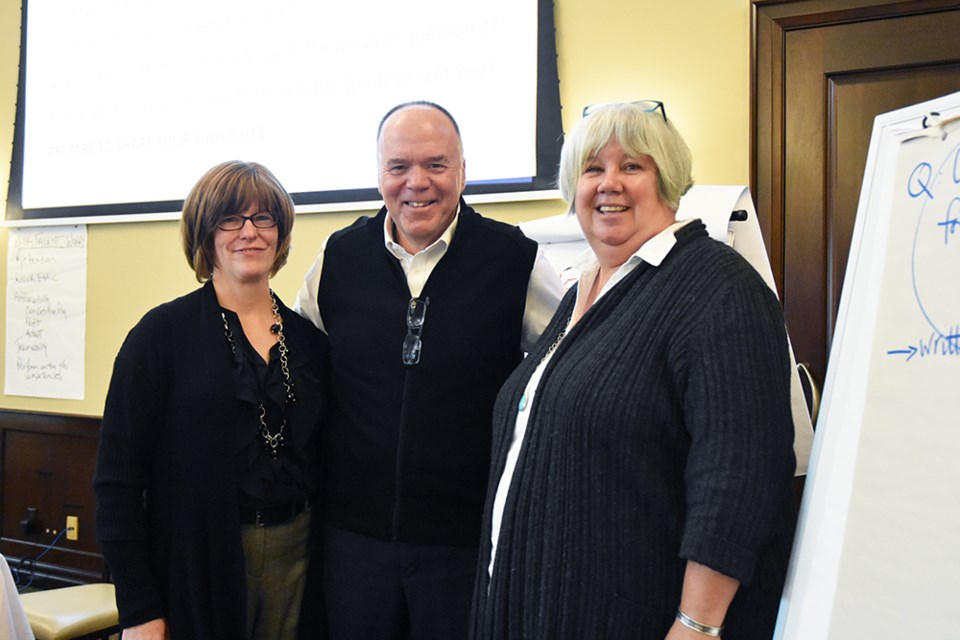To celebrate Small Business Week, Nottawasaga Futures has often partnered with its member municipalities - Simcoe County, New Tecumseth, Innisfil, Adjala-Tosorontio and Bradford West Gwillimbury – to hold a day of seminars and presentations for the business community.
This year, the organization took a slightly different approach.
Nottawasaga Futures, which supports business development and retention in South Simcoe, asked Foster Williams and Ronda Fox of Focus Business Solutions to come up with a workshop to address one of the key issues facing business today: finding and retaining the right employees.
Williams, who has 35 years of international experience in “effective integration” of workforces, policies and standards following mergers and acquisitions, and Fox, who has 25 years in the field, brought in Wendy Malkin of The HR Annex Consulting, for a hands-on workshop on 'Closing the Talent Gap.'
Held at The Club at Bond Head, the workshop attracted representatives of businesses that ranged from family-operated enterprises with a handful of employees, to medium-sized companies with multiple locations and large workforces.
“We don’t do miracles. We do hard work with intelligence,” Williams explained at the start of the event, noting that the goal was to encourage participants to think about the issues, and discover two or three solutions to the problem,"that are simple and yet easy to do."
Every business needs to be profitable, durable and sustainable, Williams said, asking, “Does anyone here think profit is a four-letter word?”
When no-one put up a hand, Williams went on, “Good! Because it’s a six-letter word,” and no business can survive without profit. “If you’re not profitable, good luck to ‘durable’ and ‘sustainable’.”
Williams asked participants to identify their biggest worries about their workforce. The responses were significant: “Will they stay?”
“Work ethic.”
“Affordability.”
“Trainability.”
Williams used statistics to help underline the challenges facing employers seeking to attract and retain a talented work force.
“Sixty-eight percent of Canadian households live paycheque to paycheque,” he noted, while less than 32 percent have over $10,000 in savings. That has big implications for employees, increasing the temptation to leave for better-paying jobs, and increasing competition for skilled workers.
And fully 20 percent of Canadians are illiterate in English or French; another 20 percent read and write at a Grade 1 to 6 level, he said – so that employers who rely on complex, printed training manuals are setting themselves up for failure.
“These are ‘secret sauces’ the employer must know,” said Williams; understanding the underlying statistics can help build winning strategies.
The workshop involved brief presentations on four “tools” for managing talent, including identifying and improving the company “Culture.”
“All companies have a culture. It’s our norms, it’s our habits,” said Williams. But what if the culture of the employees is different from the work culture?
“That’s natural,” he said; the solution is to develop clearly-stated, simple standards that can be measured – like safe operation, or meeting shipping targets – and to share them with the workforce. Those standards, he said, are the reputation of the company.
After each brief presentation – on Culture, developing leadership within the organization, retaining a skilled workforce, and looking for new employees – the participants broke into groups, to share issues and insights, and come up with solutions.
The discussion at each table was at times lively, with participants sharing their issues, and putting forward ideas as the facilitators encouraged the dialogue, with insight, and humour.
“You need the right people with the right skills in the right job, with the right leadership,” said Williams. “All of those layers… If this problem was easy to solve, do you think they need us here? We have to solve all these problems if we want to build a good company, of any size.”
The hands-on workshop approach “rather than coming to hear people talk… helps people take ownership of the one or two key ideas,” said Fox.
It’s all about “getting the foundations right from the start,” said Malkin. “The common denominator is people.”
The key, said Williams, is to be “firm, fair and consistent” in the workplace, once standards have been set.
Bad behaviour “has to be dealt with the first time,” since it impacts the culture of the company, its reputation, and other employees, he noted. “Work can be a good social place, but it’s not social services. You have to have your own standards and barriers.”
At the same time, good behaviour should be rewarded. He urged businesses to find low-cost yet effective ways to build a positive business culture, and establish that “emotional contract” with employees – from words of praise for a job well done, to potluck luncheons.
“The more you can get employees to feel like the owners of this business, the better,” added Malkin.
Bottom line, “turnover is very expensive,” Williams said – not only the cost of advertising for new employees, and interviewing, but the impact on overtime, lost productivity, and lost business.
“What you want to do is stop turnover, and then work on filling the gaps,” he said.
But he warned against calling a workforce “family.” Real families offer “unconditional love” and forgiveness, something no business can afford to do. “Be careful how you use that in business.”



